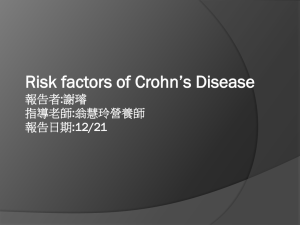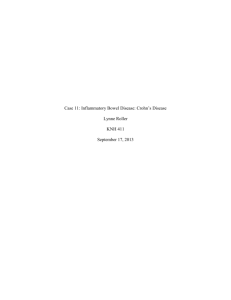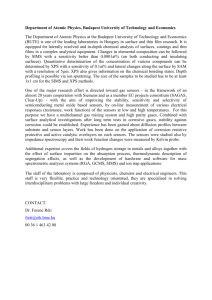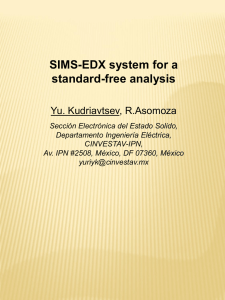File - Medical Nutrition Therapy Portfolio
advertisement
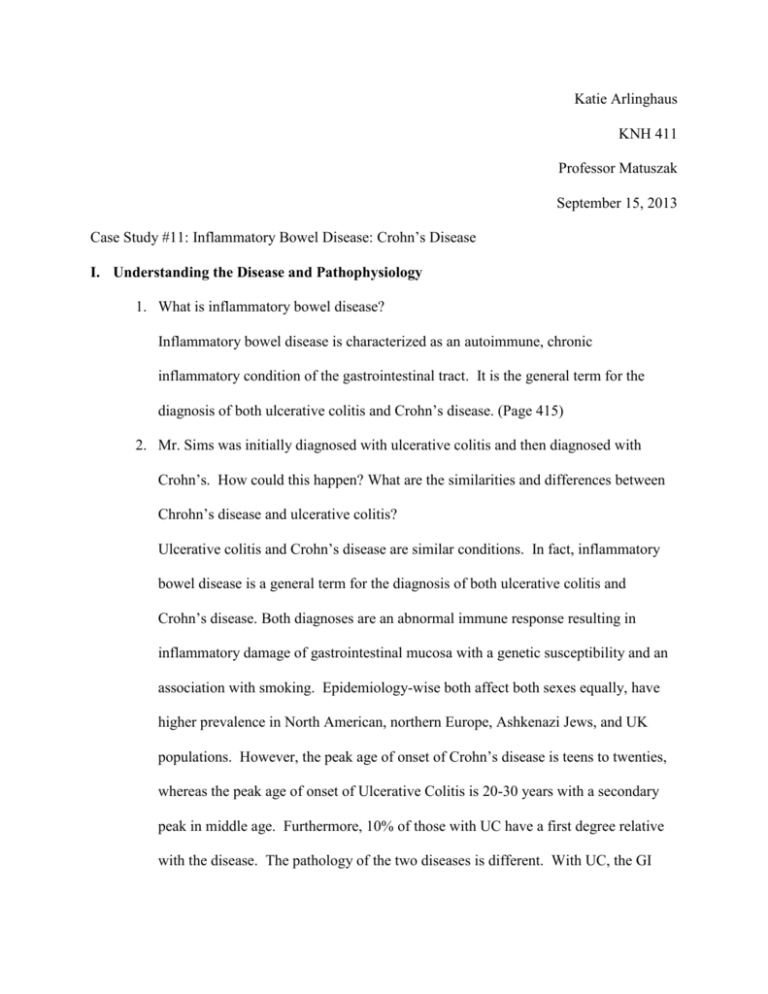
Katie Arlinghaus KNH 411 Professor Matuszak September 15, 2013 Case Study #11: Inflammatory Bowel Disease: Crohn’s Disease I. Understanding the Disease and Pathophysiology 1. What is inflammatory bowel disease? Inflammatory bowel disease is characterized as an autoimmune, chronic inflammatory condition of the gastrointestinal tract. It is the general term for the diagnosis of both ulcerative colitis and Crohn’s disease. (Page 415) 2. Mr. Sims was initially diagnosed with ulcerative colitis and then diagnosed with Crohn’s. How could this happen? What are the similarities and differences between Chrohn’s disease and ulcerative colitis? Ulcerative colitis and Crohn’s disease are similar conditions. In fact, inflammatory bowel disease is a general term for the diagnosis of both ulcerative colitis and Crohn’s disease. Both diagnoses are an abnormal immune response resulting in inflammatory damage of gastrointestinal mucosa with a genetic susceptibility and an association with smoking. Epidemiology-wise both affect both sexes equally, have higher prevalence in North American, northern Europe, Ashkenazi Jews, and UK populations. However, the peak age of onset of Crohn’s disease is teens to twenties, whereas the peak age of onset of Ulcerative Colitis is 20-30 years with a secondary peak in middle age. Furthermore, 10% of those with UC have a first degree relative with the disease. The pathology of the two diseases is different. With UC, the GI tract is unable to distinguish foreign from self-antigens and is characterized by chronic inflammation of colonic mucosa and submucosa, atrophy and possible dysplasia limited to the colon. The extent of the disease varies and may involve only the rectum left side of the colon to splenic flexure or the entire colon. With Crohn’s Disease, there is localized inflammation in bowel mucosa progressing through bowel wall. It tends to be localized in terminal ileum and colon but can involve any portion of the GI tract. Similar signs and symptoms include blood and/or mucus in stool, diarrhea, abdominal pain, fever, and weight loss. Other symptoms of UC include constipation and rectal spasm, arthritis, dermatological changes, and ocular manifestations. Symptoms of Crohn’s Disease include anorexia, malnutrition, and delayed grown in adolescents. Those with Crohn’s disease are less likely to have blood in their stool but usually have more abdominal pain and cramping. The two different diagnoses have different complications as well. Complications of UC include severe bleeding, toxic colitis, toxic megacolon, stricture, perforation, intolerance to immunosuppression, colonic strictures, dysplasia and carcinoma. Crohn’s Disease, on the other hand, can cause the complications including malabsorption, malnutrition, abdominal fistuals and abscesses, intestinal obstruction, bacterial overgrowth, gallstones, kidney stones, urinary tract infections, thromboembolic complications, perianal disease, neoplasia. Diagnosis methods for each are the same: abdominal ultrasounds, MRIs, CTs, Antiglycan antibodies, and Calprotectin, lactoferrin, and polymorphonuclear neutrophil elastase. Crohn’s Disease can also be diagnosed through clinical presentation (CDAI score), but UC cannot. Serological markers are used in antibody testing and have been used to distinguish Crohn’s Disease from UC. Since the two are very similar it is easy to see how Mr. Sims was initially diagnosed incorrectly. (Page 416). 3. A CT scan indicated bowel obstruction and the Crohn’s disease was classified as severe-fulminant disease. CDAI score of 400. What does a CDAI score of 400 indicate? What does a classification of severe-fulminant disease indicate? A CDAI score of 400 actually classifies Mr. Sims as having a moderate-severe stage of the disease (CDAI 220-450). This classification indicates that he has failed to respond to treatment for mild-moderate disease or has more major symptoms of fevers, significant weight loss, abdominal pain/tenderness, intermittent nausea/vomiting or significant anemia. Had he had a CDAI score >450, Mr. Sims would have been classified as being in the severe-fulminant disease stage. This would have indicated that he had persisting symptoms in spite of introduction of steroids or biologic agents as outpatients, or that he was presenting with high fever, persistent vomiting, evidence of intestinal obstruction, rebound tenderness, cachexia, or evidence of an abscess. Since Mr. Sims has a CDAI score above 300, though, he is considered to be having a severe exacerbation of the disease. (Page 418-419) 4. What did you find in Mr. Sims’ history and physical that is consistent with this diagnosis of Crohn’s? Explain. Much of Mr. Sims’ history and physical are consistent with the diagnosis of Crohn’s. His original dianostic workup indicated disease at the end of his jejunum and beginning of his ileum. He states that he is having abdominal pain, diarrhea, and running a fever. His abdomen is distended with extreme tenderness with rebound and guarding. He has minimal bowel sounds. Finally, Mr. Sims is very thin. These symptoms are all consistent with Crohn’s Disease. (Page 416) 5. Crohn’s patients often have extraintestinal symptoms of the disease. What are some examples of these symptoms? Is there evidence of these in his history and physical? Some extraintestinal symptoms of Crohn’s disease include osteopenia, osteoporosis, dermatitis, rheumatological conditions such as ankylosing spondylitis, ocular symptoms, and hepatobilary complications. Mr. Sims’s history and physical does not include evidence of any of these extraintestinal symptoms. (Page 418) 6. Mr. Sims has been treated previously with cortiocosteroids and mesalamine. His physician had planned to start Humira prior to this admission. Explain the mechanism for each of these medications in the treatment of Crohn’s. Cortiocosteroids work to inhibit the overall inflammatory response and are often used in acute exacerbations. There is a risk for becoming steroid dependent when using cortiocosteroids. Mesalamine is an aminosalicylate medication that is typically used with Crohn’s disease that has ileal and colon involvement (like Mr. Sims’ case). Mesalamine works as an anti-inflammatory agent in the colon and may also act as an immune suppressant. Humira binds the protein called tumor necrosis factor, which those with Crohn’s often produce too much of. The excess TNF can attack different parts of the GI tract and cause inflammation and pain, diarrhea, etc. By binding TNF, Humira reduces those symptoms. (Page 389, 418-419, http://www.dailystrength.org/treatments/Humira) 7. Which laboratory values are consistent with an exacerbation of his Crohn’s disease? Identify and explain these values. The Laboratory values consistent with an exacerbation of Crohn’s disease include testing positive for the antibody ASCA. These antibodies are more specific to Crohn’s disease than UC. Mr. Sims’ albumin levels are low, which is indicative of a severe Crohn’s case. Normal albumin levels range from 3.5-5 g/dL and Mr. Sims’ albumin is at 3.2g/dL. He also has low prealbumin at 11g/dL when normal is 1635g/dL. He also has low levels of hemoglobin and hematocrit at 12.9 g/dL and 38% respectively. Low levels of these indicate that iron is being lost. (Page 418). 8. Mr. Sims is currently on several vitamin and mineral supplements. Explain why he may be at risk for vitamin and mineral deficiencies. Mr. Sims might be at risk for vitamin and mineral deficiencies because with Crohn’s Disease malabsorption, blood loss, intestinal loss, steatorrhea, and surgical resections are all common. Long-term steroid use as well as other medications prescribed to treat Crohn’s can also interfere nutrients. Specifically, Iron deficiency can be caused from blood loss or malabsorption. Magnesium and zinc deficiencies can be caused by intestinal losses. Calcium and vitamin D deficiencies can be a result of long-term steroid use as well as a decreased intake of dairy as a result of lactose-restricted diets. Surgical resections can cause water-soluble vitamin deficiencies, especially B12. Finally, fat-soluble vitamin deficiency can be caused by steatorrhea. (Page 420). 9. Is Mr. Sims a likely candidate for short bowel syndrome? Define short bowel syndrome, and provide a rationale for your answer. Short bowel syndrome intestinal failure results from surgical resection of the small intestine, congenital defect or disease-associated loss of absorption and is characterized by the inability to maintain protein, energy, fluid, electrolyte, or micronutrient balances when on a conventionally accepted, normal diet. Since Mr Sims has had part of his small intestine removed he is a candidate for short bowel syndrome and he should be monitored for signs and symptoms. However, I do not believe that he is a strong candidate because his resection removed only a small portion of his small intestine. Most short bowel syndrome cases occur when half or more of the small intestine is removed. (Page 424, http://digestive.niddk.nih.gov/ddiseases/pubs/shortbowel/) 10. What type of adaptation can the small intestine make after resection? After the removal of part of the intestine, the remaining small intestine goes through a process of adaptation that can take up to 2 years to occur. During this time, the inner lining of the intestine grows to increase the absorptive surface area to make up for the part of the intestine that was removed. (http://digestive.niddk.nih.gov/ddiseases/pubs/shortbowel/). 11. For what classic symptoms of short bowel syndrome should Mr. Sims’ health care team monitor? Classic symptoms of short bowel syndrome that Mr. Sims’ health care team should monitor include diarrhea, cramping, bloating, heartburn, weakness and fatigue. Developing a food sensitivity could be a sign of SBS as well. Since his resection occurred in the lower jejunum and upper ileum, Mr. Sims should be monitored for carbohydrate, protein, fat, vitamin (especially B12), and bile acid deficiencies. (http://digestive.niddk.nih.gov/ddiseases/pubs/shortbowel/) 12. Mr. Sims is being evaluated for participation in a clinical trial using high-dose immunosuppression and autologous peripheral blood stem cell transplantation (autoPBSCT). How might this treatment help Mr. Sims? High-dose immunosuppression and autologous peripheral blood stem cell transplantation has been shown in clinical trials to induce remission in patients who have not responded to conventional treatments. This treatment might help Mr. Sims because immunosuppressive medications work by antagonizing purine metabolism and inhibiting the synthesis of some DNA, RNA, and proteins. AutoPBSCT might help Mr. Sims based on the premise that the inflammation he is experiencing from Crohn’s disease is a result of defective mucosal T cells. AutoPBSCT would replace these defective T-cells with hempatopoietic cells from a healthy donor. (Page 390, http://clinicaltrials.gov/show/NCT00692939) II. Understanding the Nutrition Therapy 13. What are the potential nutritional consequences of Crohn’s disease? There are multiple nutrient deficiencies that are commonly seen with Crohn’s disease. Protein deficiency occurs from increased protein needs from losses from GI tract due to inflammation, catabolism, or healing from surgery. Short bowel syndrome and highvolume diarrhea can cause fluid and electrolyte deficiency. Iron deficiency occurs from malabsorption and blood loss. Intestinal losses, especially form short bowel syndrome or diarrhea can cause magnesium and zinc deficiencies. Calcium and vitamin D can be deficient due to long-term steroid use or a decreased intake of dairy foods as a result of lactose-restricted diets. Surgical resections of stomach (intrinsic factor) and/or of the terminal ileum can cause water-soluble vitamin deficiencies especially B12. Steatorrhea can cause a deficiency in fat-soluble vitamins and medications can result in folate deficiency. Finally, total energy intake is commonly deficient with Crohn’s disease because of increased energy requirements, fear of abdominal pain or diarrhea after eating, anorexia, and just insufficient caloric intake. (Page 420) 14. Mr. Sims underwent resection of 200 cm of jejunum and proximal ileum with palacement of jejunostomy. The ileocecal valve was preserved. Mr. Sims did not have an ileostomy, and his entire colon remains intact. How long is the small intestine, and how significant is this resection? The small intestine is approximately 3 meters long, with 2.75 meters of that being composed of the jejunum and ileum. Mr. Sims’ resection is not that significant as his colon is still intact and he doesn’t need to have an outside surgical apparatus. No stoma was necessary. (Page 423, Medeiros, 34). 15. What nutrients are normally digested and absorbed in the portion of the small intestine that has been resected? The small intestine is responsible for the absorption of the bulk of nutrients. Specifically, the absorption lipids and fat-soluble vitamins occurs in the jejunum. Carbohydrates, amino acids, and water-soluble vitamins are absorbed in the jejunum and upper ileum, and the absorption of vitamin B12 and bile salts occur in the terminal ileum. Water is absorbed throughout the GI tract including in the area of the small intestine that has been resected. (http://www.shortbowelfoundation.org/index.php/education/2011-03-10-22-2233, facweb.northseattle.edu/.../DIGESTIONandABSORPTION%5B1%5D.ppt) III. Nutrition Assessment 16. Evaluate Mr. Sims’ % UBW and BMI. Height: 5’9”*0.0254m=1.75m Weight:140lbs/2.2kg=65.45kg BMI=weight (in kg)/ht (meters)2 BMI=65.45/1.752 BMI=21.37=21kg/m2 UBW=166-168lbs % UBW=(current weight/usual body weight)*100 %UBW=(140/166)*100= 84% %UBW=(140/168)*100=83% %UBW=83-84% (Page 47-48) 17. Calculate Mr. Sims’ energy requirements. Height: 5’9”*2.54m=175.26cm Weight:140lbs/2.2kg=65.45kg Using Mifflin-St. Jeor with stress factor of 1.4: REE=(10(weight in kg)+6.25(height in cm)-5(age in years)+5)1.4 REE=(10(65.45)+6.25(175.26)-5(35)+5)1.4 REE=2,211kcal Using physical activity factor of 1.2 because Mr. Sims is in the hospital and mostly bed bound: EER=2,211*1.2=2,653kcal. (Page 48, 421) 18. What would you estimate Mr. Sims’ protein requirements to be? Protein requirements are based on presence of any lean body mass wasting and biochemical parameters measuring protein status such as prealbumin and albumin. For adults, protein needs vary from 1.5-1.75g of protein per kg of body weight. Therefore Mr. Sims would need between 98g-114.5g protein. (Page 421) Weight:140lbs/2.2kg=65.45kg 65.45kg*1.5g=98.175g 65.45kg*1.75g=114.54 19. Identify any significant and/or abnormal laboratory measurements from both his hematology and his chemistry labs. Mr. Sims’s protein, albumin, and prealbumin levels were all too low indicating a protein deficiency. Total protein was at 5.5g/dL (should be 6-8g/dL), albumin was at 3.2g/dL (should be 3.5-5g/dL), and Prealbumin was 11mg/dL (should be 16-35mg/dL). Mr. Sims’ HDL-C was too low at 38mg/dL (should be above 45), although this total cholesterol and LDL values were okay. Mr. Sims tested positive for ASCA, which is very indicative of having Crohn’s disease. His hematology labs shows that he had too low of hemoglobin, hematocrit, transferring, ferritin, Vitamin D, Free retinol, and ascorbic acid levels. He also had too high of a ZPP level. This shows that he is deficient in iron, vitamin D, vitamin A, and vitamin C. It also indicated that his zinc levels are abnormal. IV. Nutrition Diagnosis 20. Select two nutritional problems and complete the PES statement for each. Increased protein needs related to Crohn’s disease as evidenced by laboratory results of albumin levels of 5.5g/dL, prealbumin level of 11mg/dL, and total protein level of 5.5g/dL. Inadequate energy intake related to Crohn’s disease as evidenced by patient’s report of recent dietary intake. V. Nutrition Intervention 21. The surgeon notes Mr. Sims probably will not resume eating by mouth for at least 710days. What information would the nutrition support team evaluate in deciding the route for nutrition service? In deciding the appropriate route for nutrition service the nutrition support team would evaluate the extent of intestinal involvement, previous surgeries, diarrheal output, and bleeding. Enteral nutrition is recommended when use of medications is not feasible or when additional nutrition is needed to improve nutritional status. Enteral nutrition studies have shown that supplementation may play a role in modifying the inflammatory response in the disease process, but has not been shown to play a role in remission states. (Page 421) 22. The members of the nutrition support team note his serum phosphorus and serum magnesium are at the low end of the normal range. Why might that be of concern? A low end of normal range serum magnesium level may indicate that Mr. Sims is moving towards a magnesium deficiency, which is frequently observed with chronic diarrhea from Crohn’s disease. A low fat diet can improve magnesium balance when this is the case because the malabsorption of magnesium is secondary to the formation of insoluble magnesium soaps. In particular, the low level of magnesium could indicate short bowel syndrome. The low end of normal range serum phosphorus level may also indicate that Mr. Sims is moving towards a phosphorus deficiency as well. In particular, the low level of magnesium and phosphorus could indicate short bowel syndrome or refeeding syndrome. (http://www.ncbi.nlm.nih.gov/pmc/articles/PMC1855626/, Page 420) 23. What is refeeding syndrome? Is Mr. Sims at risk for this syndrome? How can it be prevented? Refeeding syndrome is a term used to describe several common metabolic alterations that may occur during nutritional repletion of starved patients. Mr. Sims is at risk for this syndrome because he is slightly malnourished, has a history of inadequate oral intake, and is currently only having clear liquids. To prevent refeeding syndrome it is imperative that his serum levels of phosphorus, magnesium, and potassium are monitored (especially as they are currently at the low end of normal). He should also be provided supplementation until he can reach his goal feedings, and he should be introduced to feedings slowly as to avoid overfeeding. (Page 92) 24. Mr. Sims was placed on parenteral nutrition support immediately postoperatively, and a nutrition support consult was ordered. Initially, he was prescribed to receive 200g dextrose/L, 42.5g amino acids/L, and 30g lipid/L. His parenteral nutrition was initiated at 50 cc/hr with a goal rate of 85 cc/hr. Do you agree with the team’s decision to initiate parenteral nutrition? Will this meet his estimated nutritional needs? Explain. Calculate: pro (g); CHO (g); lipid (g); and total kcal from his PN. Most research has shown that PN with bowel rest is not needed and clinical trials have shown that it does not result in improved outcomes of remission. The only time that PN seems necessary is immediately following an operation until adequate intestinal adaptation has occurred. Through PN (assuming 24 hours of time), Mr. Sims is receiving 240-408g CHO, 51-87g Pro, and 36-61g Lipids: 1cc=0.001L 50cc*0.001L*200g Dextrose/L=10g dextrose per hour*24hours=240g CHO 85cc*0.001L*200g Dextrose/L=17g dextrose per hour*24hours=408g CHO 240-408g CHO 50cc*0.001L*42.5g amino acids/L=2.1g amino acids per hour*24hours=51g Protein 85cc*0.001L*42.5g amino acids/L=3.6g amino acids per hour*24hours=86.7g Protein 51-87g Protein 50cc*0.001L*30g lipids/L=1.5g lipids per hour*24 hours=36g lipids 85cc*0.001L*30g lipids/L=2.55g lipids per hour*24 hours=61.2g lipids 36-61g Lipids 240g CHO*4kcal/gCHO=960kcal CHO 408g CHO*4kcal/gCHO=1632kcal CHO 960-1632kcal CHO 51g Pro*4kcal/gPro =204kcal Pro 87g Pro*4kcal/gPro =348kcal Pro 204-348kcal Pro 36gLipids*9kcal/gLipid=324kcal Lipids 61gLipids*9kcal/gLipid=549kcal Lipids 324-549kcal Lipids Total kcal=960kcal CHO + 204kcal Pro + 324kcal Lipids = 1,488kcal Total kcal=1632kcal CHO + 348kcal Pro + 549kcal Lipids = 2,529kcal Total kcal: 1,488-2,529kcal This does not meet his calorie need of 2,653kcal as calculated using the Mifflin-St. Jeor method. Nor does it meet his protein need of 98-114g protein. However, it is important to increase energy intake gradually as to prevent overfeeding. 25. For each of the PES statements you have written, establish an ideal goal (based on the signs and symptoms) and an appropriate intervention (based on the etiology). Ideal goal: Gradually increase Mr. Sims’ protein intake to 98g-114.5g protein via enteral or parenteral nutrition until his Crohn’s is under control and can begin to gradually increase is oral intake of protein. Ideal goal: Gradually increase Mr. Sims’ overall energy intake to 2,655kcal through the use of eteral or parenteral nutrition until Crohn’s is in remission. Provide Mr. Sims and his wife education and guidance on the importance of implanting an appropriate diet as means to control his Crohn’s and prevent malnutrition. VI. Nutrition Monitoring and Evaluation 26. Indirect calorimetry reveal the following information: Measure Mr. Sims’ Data Oxygen consumption (mL/min) 295 CO2 production (mL/min) 261 RQ 0.88 RMR 2022 What does this information tell you about Mr. Sims? Indirect calorimetry is an approach to determine the energy expenditure by measuring a subject’s oxygen consumption, carbon dioxide production, and minute ventilation. From this information Mr. Sims’ energy requirements can be accurately calculated so that the adequacy and appropriateness of nutritional support can be monitored. RMR or resting metabolic rate is the amount of energy Mr. Sims needs without any activity (2022kcal). RMR can be calculated using the RQ, respiratory quotient, which is the ratio of CO2 eliminated over O2 consumed. (Page 244) 27. Would you make any changes to his prescribed nutrition support? What should be monitored to ensure adequacy of his nutrition support? Explain I would increase the amount of protein prescribed in his nutrition support. This would also increase his total kcal. Currently his protein and total energy prescribed does not meet his calculated energy and protein needs of 2,655kcal and 98g-114.5g protein respectively. I would monitor his albumin, prealbumin, and total protein to ensure the adequacy of his nutrition support. I would monitor his hematology report, specifically hemoglobin, hematocrit, transferrin, and ferritin to ensure that he was receiving adequate iron. I would monitor his weight to ensure that he was intaking enough energy. Finally, I would monitor his ZPP, vitamin D, Free retinol, and ascorbic acid to ensure that he was absorbing adequate amounts of zinc, vitamin d, vitamin A, and vitamin C. 28. What should the nutrition support team monitor daily? What should be monitored weekly? Explain your answers. Mr. Sims’ bowel movements should be monitored daily. As diarrhea subsides, he may be able to move away from PN and begin to intake orally. It would also be important to weigh Mr. Sims daily to monitory that he is receiving enough energy. I would monitor his albumin, prealbumin, and total protein weekly to ensure the adequacy of his nutrition support. I would monitor his hematology report, specifically hemoglobin, hematocrit, transferrin, and ferritin to ensure that he was receiving adequate iron. Finally, weekly I would monitor his ZPP, vitamin D, Free retinol, and ascorbic acid to ensure that he was absorbing adequate amounts of zinc, vitamin d, vitamin A, and vitamin C. (Page 421) 29. Mr. Sims’ serum glucose increase to 145 mg/dL. Why do you think this level is now abnormal? What should be done about it? This level is now probably abnormal because the only form of CHO Mr. Sims is receiving is dextrose. It makes sense that his glucose level would raise. His antiinflammatory medicine may also be increasing his blood glucose levels. As his condition becomes more stable, Mr. Sims should have complex carbohydrates instead of just dextrose. Currently, however, the easily digested and absorbed form of sugar is appropriate for him. (http://www.nlm.nih.gov/medlineplus/ency/article/002469.htm). 30. Evaluate the following 24-hour urine data: 24-hour urinary nitrogen for 12/20: 18.4 grams. By using the daily input/output record for 12/20 that records the amount of PN received, calculate Mr. Sims’ nitrogen balance on postoperative day 4. How would you interpret this information? Should you be concerned? Are there problems with the accuracy of nitrogen balance studies? Explain. Nitrogen balance=(dietary protein intake/6.25)-urine urea nitrogen Dietary protein intake ~70g Nitrogen balance = (70/6.25)-18.4g = -7.2g Therefore, Mr. Sims is in a negative nitrogen balance. A negative nitrogen balance indicates that his nitrogen excretion is greater than his intake. This is concerning but is most likely due to his diarrhea. It is also indicative that he may need more protein. Limitations of measuring nitrogen balance include the inherent error of 24-hour urine collection, failure to account for renal impairment, and the inability to measure nitrogen losses from wounds, burns, diarrhea, and vomiting. The loss from diarrhea is especially important in Mr. Sims’ case. Oral protein intake may also be difficult to measure. (Page 54) 31. On post-op day 10, Mr. Sims’ team notes he has had bowel sounds for the previous 48 hours and had his first bowel movement. The nutrition support team recommends consideration of an oral diet. What should Mr. Sums be allowed to try first? What would you monitor for tolerance? If successful, when can the parenteral nutrition be weaned? When oral intake can be initiated a low-residue, lactose-free diet with small, frequent meals is best tolerated. Fiber and lactose should be added in small amounts as tolerated to advance the diet. Gas-producing foods, spicy foods, fried foods, caffeinated beverages should be avoided. Parenteral nutrition can be weaned as Mr. Sims responds to medical therapy. (Page 421) 32. What would be the primary nutrition concerns as Mr. Sims prepared for rehabilitation after his discharge? Be sure to address his need for supplementation of any vitamins and minerals. Identify two nutritional outcomes with specific measures for evaluation. During his remission, Mr. Sims should maximize energy and protein intake to facilitate rehabilitation. Physical activity would also help to rebuild muscle mass and protein stores. Mr. Sims should consume foods high in antioxidants and omega-3 fatty acids, as these have been shown to reduce inflammation. It would also be important for him to supplement iron and B12. Furthermore, the use of probiotics has been shown to enhance the normal flor of the GI tract and as been associated with decreased IBD symptoms. Mr. Sims should concentrate on the nutritional outcome of gaining weight. He should try to gain 1-2 pounds a week to reach his previous weight of around 160lbs. He should also increase his physical activity to ensure the rebuilding of protein stores and muscle mass. This can be evaluated through a lab test of protein with his goal measurement being in the normal range of 6-8g/dL of total protein. (Page 422) References Short Bowel Syndrome Foundation. (2013). Digestive Anatomy. Retrieved from http://www.shortbowelfoundation.org/index.php/education/2011-03-10-22-22-33 MedlinePlus. (2013). Carbohydrates. Retrieved from http://www.nlm.nih.gov/medlineplus/ency/article/002469.htm. Nelms M, Sucher K, Lacey, K., Habash, D., Roth S. Nutrition Therapy and Pathophysiology. 2nd ed.Belmonte, CA: Thomson Brooks/Cole, 2010. North Seattle Community College (2012). Digestion and Absorption. Retrieved from facweb.northseattle.edu/.../DIGESTIONandABSORPTION%5B1%5D.ppt Swaminathan R. (2003). Magnesium Metabolism and its Disorders. Retrieved from http://www.ncbi.nlm.nih.gov/pmc/articles/PMC1855626/. US Department of Health and Human Services, National Digesetive Disease Information Clearinghouse. (2013). Short Bowel Syndrome. Retrieved from http://digestive.niddk.nih.gov/ddiseases/pubs/shortbowel/. US National Institute of Health. (2012). Autologous Stem Cell Transplantation for Crohn’s Disease. Retrieved from http://clinicaltrials.gov/show/NCT00692939.

